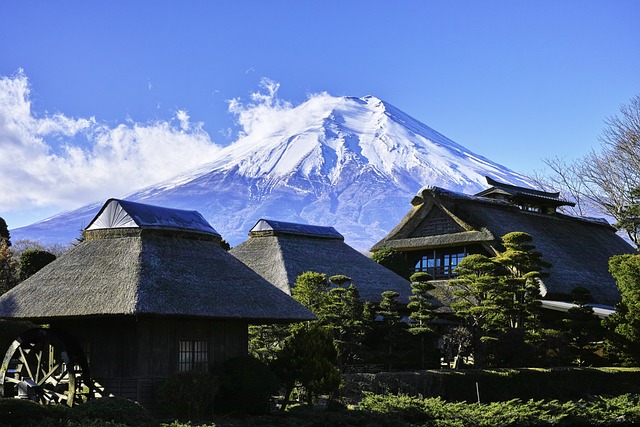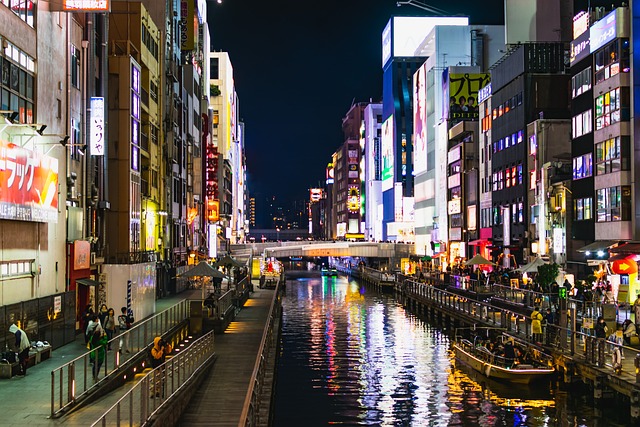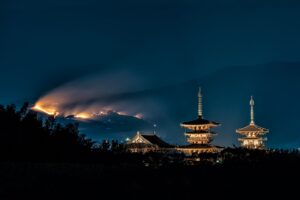
Mount Fuji is located in Japan and is an iconic and active stratovolcano, standing at 3,776 meters (12,389 feet) tall. Mount Fuji is situated on Honshu Island, specifically within the borders of Yamanashi and Shizuoka Prefectures. It is the highest peak in Japan and is considered one of Japan’s three sacred mountains, along with Mount Tate and Mount Haku. Additionally, Mount Fuji is a UNESCO World Heritage Site and attracts numerous climbers and tourists from around the world each year. Mount Fuji’s combination of natural beauty, cultural significance, outdoor activities, and cultural experiences makes it a must-visit destination for tourists from around the world.
Mount Fuji is a popular tourist attraction for several reasons. Mount Fuji holds immense cultural and spiritual significance in Japan. It is considered a sacred site in Shintoism, Japan’s indigenous religion. Many people undertake pilgrimages to the mountain for spiritual reasons, and it has been depicted in numerous works of art, literature, and poetry throughout Japanese history. Mount Fuji’s iconic symmetrical cone shape and picturesque surroundings make it a stunning natural sight to behold. The mountain is particularly beautiful during the cherry blossom season in spring and when covered in snow during the winter months. Mount Fuji offers various climbing routes, catering to both experienced climbers and casual hikers. Climbing Mount Fuji is a popular activity during the summer months when the weather conditions are most favorable. Many tourists aim to reach the summit to witness the breathtaking views of the surrounding landscapes and the sunrise from the peak.
Mount Fuji’s majestic presence provides numerous opportunities for photographers to capture stunning images from different vantage points. The mountain serves as a backdrop for many iconic Japanese landscapes, making it a favorite subject for photographers. Visiting Mount Fuji allows tourists to immerse themselves in Japanese culture and traditions. Nearby towns and villages offer authentic Japanese cuisine, hot springs (onsen), traditional ryokan accommodations, and cultural experiences such as tea ceremonies, making it an enriching cultural experience for visitors.
Reaching Mount Fuji from Tokyo is relatively straightforward, and there are several transportation options available. Here are some common ways to reach Mount Fuji from Tokyo: By Train: Take the JR Tokaido Shinkansen (bullet train) from Tokyo Station to Shin-Fuji Station or Mishima Station. From there, transfer to local trains or buses that will take you to the Fuji Five Lakes area, which is near the base of Mount Fuji. Alternatively, take the JR Chuo Line from Tokyo Station to Otsuki Station. From Otsuki Station, transfer to the Fujikyu Railway and take the Fujisan Limited Express train to Kawaguchiko Station, which is also near the Fuji Five Lakes area. By Bus: Many tour operators and bus companies offer direct bus services from Tokyo to the Fuji Five Lakes area. These buses typically depart from major stations such as Shinjuku Station or Tokyo Station and provide convenient transportation to popular tourist spots around Mount Fuji. By Car: Renting a car is another option for traveling from Tokyo to Mount Fuji. The journey takes approximately 2 to 3 hours, depending on traffic conditions and the specific destination around Mount Fuji. Take the Chuo Expressway or Tomei Expressway and follow the signs for Mount Fuji or the Fuji Five Lakes. Organized Tours: There are many organized day trips and guided tours available from Tokyo to Mount Fuji. These tours often include transportation, guided sightseeing, and sometimes additional activities such as hiking or visiting nearby attractions. Before traveling, it’s essential to check the current transportation schedules, ticket availability, and any travel restrictions or advisories. Additionally, consider the weather conditions and time of year, as visibility of Mount Fuji can vary depending on the season.
When traveling to Mount Fuji by train, the best side to sit on depends on the direction you’re traveling from and your preferences for viewing the mountain. Here are some general guidelines: Tokyo to Mount Fuji (Westbound): If you’re traveling from Tokyo to Mount Fuji (westbound), consider sitting on the right side (seats facing forward). This side of the train typically offers better views of Mount Fuji as you approach the mountain from the east. Mount Fuji to Tokyo (Eastbound): If you’re traveling from Mount Fuji to Tokyo (eastbound), consider sitting on the left side (seats facing forward). This side of the train may provide better views of Mount Fuji as you depart from the mountain and head towards Tokyo.
Summer is also the time when Mount Fuji can be clearly seen from a Shinkansen train leaving Tokyo towards Nagoya – Osaka – Kyoto. The window view is impressive – make sure to reserve your D or E seat (C or D in Green Cars), which is the right side from Tokyo, left side from Kyoto.
Keep in mind that visibility of Mount Fuji can vary depending on weather conditions, such as cloud cover or haze. Even if you sit on the recommended side, there’s no guarantee of clear views. Different train lines and routes may offer varying views of Mount Fuji. Research the specific train line you’ll be traveling on to determine the best seating options. If viewing Mount Fuji is a top priority for your journey, consider choosing a transportation option (such as a bus tour or scenic train) that specifically highlights views of the mountain. Ultimately, the best side to sit on for viewing Mount Fuji may vary depending on factors such as weather conditions, train route, and personal preferences. If possible, remain flexible and be prepared to enjoy the scenic views from whichever side of the train offers the best visibility during your journey.
There are numerous attractions and points of interest to explore around Mount Fuji. Here are some popular destinations and activities near Mount Fuji: Fuji Five Lakes (Fujigoko): The Fuji Five Lakes region comprises five scenic lakes—Lake Kawaguchi, Lake Yamanaka, Lake Saiko, Lake Shoji, and Lake Motosu—located at the northern base of Mount Fuji. Each lake offers its own unique views of the mountain, as well as opportunities for boating, fishing, and hiking. Lake Ashi (Ashinoko): Lake Ashi is a picturesque crater lake located in Hakone, southwest of Mount Fuji. Visitors can enjoy boat cruises on the lake, which offer stunning views of Mount Fuji on clear days. The Hakone Shrine and Hakone Open-Air Museum are also popular attractions near Lake Ashi. Hakone Ropeway and Owakudani: The Hakone Ropeway is a cable car system that provides panoramic views of the Owakudani volcanic valley, hot springs, and Lake Ashi. Owakudani, also known as the Great Boiling Valley, is a volcanic area known for its sulfur vents and black egg delicacies. Fuji-Q Highland: This amusement park is located near the base of Mount Fuji and offers a variety of thrill rides, roller coasters, and attractions for visitors of all ages. It is home to some of the world’s fastest and tallest roller coasters, including the famous Fujiyama and Dodonpa. Chureito Pagoda: The Chureito Pagoda is a five-story pagoda located in Arakurayama Sengen Park in Fujiyoshida City. It offers one of the most iconic views of Mount Fuji, especially during the cherry blossom season in spring when the pagoda is surrounded by blooming cherry trees. Fuji Subaru Line 5th Station: The Fuji Subaru Line 5th Station is one of the most popular starting points for climbers attempting to summit Mount Fuji. It offers visitor centers, souvenir shops, restaurants, and stunning views of the surrounding landscape. Shizuoka Tea Plantations: Shizuoka Prefecture, located on the southern slopes of Mount Fuji, is famous for its tea plantations. Visitors can tour tea farms, participate in tea tastings, and learn about the traditional cultivation and production of Japanese green tea. These are just a few of the many attractions and activities to explore around Mount Fuji. Whether you’re interested in outdoor adventure, cultural experiences, or stunning natural scenery, the area surrounding Mount Fuji offers something for everyone.
Fuji-Q Highland
Fuji-Q Highland is easily accessible from Tokyo by train or bus, making it a popular destination for day trips or weekend getaways. It offers something for everyone, from adrenaline-pumping roller coasters to family-friendly attractions and entertainment, making it a must-visit destination for thrill-seekers and amusement park enthusiasts alike. Fuji-Q Highland is an amusement park located near the base of Mount Fuji in Fujiyoshida City, Yamanashi Prefecture, Japan. It is one of the largest and most popular theme parks in Japan, offering a wide variety of thrill rides, attractions, and entertainment for visitors of all ages. Here are some key features of Fuji-Q Highland: Thrill Rides: Fuji-Q Highland is known for its extensive collection of thrill rides, including some of the world’s fastest and tallest roller coasters. Some of the park’s most famous roller coasters include: Fujiyama: Once the tallest and fastest roller coaster in the world, Fujiyama offers breathtaking views of Mount Fuji as it reaches speeds of up to 130 km/h (80 mph). Takabisha: Known for its steep 121-degree drop, Takabisha is the steepest roller coaster in the world. It features multiple inversions and reaches speeds of up to 100 km/h (62 mph).
Eejanaika: This 4D roller coaster features spinning seats that rotate independently, providing a unique and exhilarating experience for riders. Family Attractions: In addition to thrill rides, Fuji-Q Highland offers a variety of family-friendly attractions and entertainment options, including: Thomas Land: A themed area based on the popular children’s character Thomas the Tank Engine, featuring rides, attractions, and play areas suitable for young children. Fuji Airways: An immersive flight simulation ride that takes visitors on a virtual tour of Mount Fuji and the surrounding landscape. Haunted Attractions: The park is also home to several haunted attractions and horror-themed experiences, including haunted houses and interactive scare zones, perfect for thrill-seekers looking for a fright. Seasonal Events: Fuji-Q Highland hosts various seasonal events and festivals throughout the year, including Halloween events, Christmas illuminations, and limited-time ride attractions. Views of Mount Fuji: On clear days, visitors to Fuji-Q Highland can enjoy stunning views of Mount Fuji from various vantage points within the park, adding to the overall scenic beauty and atmosphere.
MOUNT FUJI 5th STATION
Mt. Fuji 5th Station : At 7,546 feet (2,300 meters), Mt. Fuji’s 5th Station affords incredible views over Fuji Five Lakes and Hakone National Park. Easily accessible by road, 5th Station lies at the midpoint of the Yoshida Trail to Mount Fuji’s summit; many hikers begin their ascent here. Most visitors explore Mt. Fuji 5th Station on a day trip from Tokyo, combined with other attractions in Fuji-Hakone-Izu National Park. A typical day tour itinerary includes a Lake Ashi boat cruise and a ride on Mount Komagatake’s ropeway; a visit to Oishi Park and Mount Kachi Ropeway; or activities, such as fruit picking, wine tasting, or a soak in a traditional onsen (hot spring). Mt. Fuji 5th Station also serves as the starting point for hikes to the summit. From 5th Station, the observation point offers unobstructed views of Fuji Five Lakes, Fujiyoshida City, and Lake Yamanaka. Weather permitting, it’s possible to visit Mt. Fuji 5th Station year-round. During summer, when the hiking trail is open (July to mid-September), the station can get extremely busy, and the access road is closed to private vehicles—shuttle buses run between car parks at the bottom of the mountain. In winter, heavy snow can sometimes hinder access. Scaling the 12,389-feet (3,776-meter) summit of Japan’s highest mountain is a popular challenge for adventurous travelers. Yoshida Trail is the busiest route to the top, with more than 170,000 climbers annually. It’s only open for two months each summer, and the ascent takes between five and six hours, with the descent taking three to four. Many hikers start out in the middle of the night in order to reach the summit in time for sunrise. Mt. Fuji attracts hikers and climbers from the world over, and most of them start their ascents at the 5th station, halfway up the mountain. If climbing Mt. Fuji to its summit doesn’t fit into your travel schedule but you want to experience the atmosphere of this symbol of Japan, you can climb or drive to Fuji Subaru Line 5th Station for spectacular views.
Fuji Subaru Line 5th Station is in southeastern Yamanashi Prefecture near the border with Shizuoka Prefecture and can be accessed by bus, car or taxi. Take an express train from Shinjuku Station to Otsuki Station on the JR Chuo Line (about an hour), then change to the Fuji Kyuko Line for Fujisan Station or Kawaguchiko Station. The express train, Fujisan Tokkyu, takes 45 minutes and the regular train takes about an hour to reach Kawaguchiko Station. You can take a bus to Kawaguchiko Station from Shin-Fuji Station (2 hours 15 minutes) or Mishima Station (90 minutes), which are both on the Tokaido Shinkansen Line. Once you arrive at either Fujisan Station or Kawaguchiko Station, you can take a bus to Fuji Subaru Line 5th Station. You can get to Fuji Subaru Line 5th Station via bus from Shinjuku Expressway Bus Terminal in just under two and a half hours.
LAKE KAWAGUCHI

One of Osaka’s most iconic entertainment districts, Dotonbori is known for its vibrant nightlife, bustling streets, and dazzling neon lights. Visitors can stroll along the canal, sample local street food, and take photos with landmarks like the Glico Running Man and Kani Doraku Crab.
Dotonbori is one of Osaka’s most iconic and vibrant entertainment districts, renowned for its bustling atmosphere, dazzling neon lights, and mouthwatering street food. Dotonbori is located in the Namba district of Osaka, along the Dotonbori Canal, which runs parallel to the Dotonbori Street. It’s easily accessible from major transportation hubs such as Namba Station and Osaka Station. Dotonbori is famous for its extravagant neon lights and giant signboards, which adorn the buildings and line the streets. Some of the most recognizable landmarks include the Glico Running Man, Kani Doraku Crab, and the giant blowfish of Zuboraya.
HAKONE
Hakone is a popular tourist destination located in the Kanagawa Prefecture of Japan, approximately 100 kilometers southwest of Tokyo. Here are some key features and attractions of Hakone: Hot Springs (Onsen): Hakone is renowned for its natural hot springs, known as onsen. Visitors can relax and rejuvenate in various hot spring resorts scattered throughout the region. Many ryokan (traditional Japanese inns) offer private baths and open-air baths with stunning views of the surrounding nature. Scenic Views of Mount Fuji: Hakone offers some of the best views of Mount Fuji, Japan’s highest and most iconic peak. On clear days, visitors can catch glimpses of Mount Fuji from viewpoints such as Lake Ashi (Ashinoko), Owakudani, and the Hakone Ropeway. Lake Ashi (Ashinoko): Lake Ashi is a picturesque crater lake formed by volcanic activity. Visitors can enjoy boat cruises on the lake, offering panoramic views of Mount Fuji and the surrounding mountains. The Hakone Shrine, located at the lakeside, is a popular spot for photography. Hakone Open-Air Museum: This outdoor museum features a vast collection of modern and contemporary sculptures by renowned Japanese and international artists. Visitors can explore the sculpture gardens, art galleries, and interactive exhibits set amidst beautiful natural surroundings. Hakone Ropeway: The Hakone Ropeway is a cable car system that provides breathtaking aerial views of the Owakudani volcanic valley, hot springs, and Lake Ashi. The ropeway connects various attractions, including Owakudani, Togendai, and Sounzan. Owakudani (Great Boiling Valley): Owakudani is a volcanic valley known for its active sulfur vents, hot springs, and geysers. Visitors can explore the area’s volcanic terrain, purchase black eggs (kuro-tamago) boiled in the natural hot springs, and enjoy panoramic views of the surrounding landscape. Hakone Shrine: Situated on the shores of Lake Ashi, Hakone Shrine is a Shinto shrine known for its iconic red torii gate standing in the water. The shrine complex includes several buildings and walking paths surrounded by lush forest. Hakone Pirate Ship: These replica pirate ships offer scenic cruises on Lake Ashi, providing a unique and memorable way to experience the beauty of Hakone’s natural surroundings. Hakone is easily accessible from Tokyo by train, bus, or car, making it a popular day trip or weekend getaway destination for both domestic and international travelers.
Dotonbori is a haven for food lovers, offering a wide array of delicious street food and local specialties. Visitors can sample Osaka’s iconic dishes such as takoyaki (octopus balls), okonomiyaki (savory pancakes), kushikatsu (deep-fried skewers), and takoyaki-shaped desserts. In addition to street food stalls, Dotonbori is home to numerous restaurants, izakayas (Japanese pubs), and eateries serving a variety of cuisines, including sushi, ramen, yakiniku (grilled meat), and more. Many establishments are open late into the night, making it a popular spot for dining and nightlife.
Dotonbori offers a diverse range of shopping opportunities, from trendy boutiques and department stores to souvenir shops and specialty stores. Visitors can shop for fashion, electronics, cosmetics, and unique gifts while exploring the bustling streets of the district. Dotonbori is not only about food and shopping but also offers entertainment options such as theaters, arcades, and bars. Visitors can catch a live performance at the Dotonbori Theater, try their luck at a pachinko parlor, or enjoy drinks at a rooftop bar overlooking the city. One of the best ways to experience Dotonbori is by taking a sightseeing cruise along the Dotonbori Canal. Boat tours offer scenic views of the district’s iconic landmarks and illuminated signboards, providing a unique perspective of the area. Dotonbori is a must-visit destination for anyone exploring Osaka, offering a sensory overload of sights, sounds, and flavors that capture the essence of the city’s vibrant culture and bustling energy.
References
- https://www.rihga.com/osaka/location
- https://youtu.be/GjqIQ64qZhg
- https://youtu.be/htxVoNBd5do
- https://youtu.be/mX8cz1LEeXw
- https://youtu.be/cts_6n8aPUM
- https://youtu.be/SYUqr5wQMXU
- https://youtu.be/S20luAipFrE
- https://youtu.be/NHY0w8_dnNw
- https://www.klook.com/en-IN/experiences/list/yamanashi-day-trips/c4529-cate10/
- https://www.getyourguide.com/fujikawaguchiko-l145166/
- https://www.japan.travel/en/spot/1309/
- https://tokyocheapo.com/travel/tokyo-to-mount-fuji-transport/ (Guide to get to Mount Fuji)
- https://www.jrailpass.com/blog/fuji-excursion-train
- https://highway-buses.jp/course/fuji-5th.php
- https://highway-buses.jp/course/kawaguchiko-onedaytrip.php
- https://highway-buses.jp/course/mtfuji-route.php
- https://www.klook.com/en-IN/activity/97900-mt-fuji-honcho-street-oishi-park-join-one-day-bus-tour-tokyo/?spm=SearchResult.SearchResult_LIST&clickId=09e0c5c561
- https://www.jrailpass.com/blog/mount-fuji
- https://www.jrailpass.com/blog/climbing-mount-fuji
- https://www.kkday.com/en/blog/57595/asia-japan-how-to-diy-your-mount-fuji-day-trip-from-tokyo#:~:text=If%20you%20plan%20on%20taking,Fuji.
- https://japanstartshere.com/mt-fuji-travel-guide/
- https://tokyocheapo.com/travel/tokyo-to-mount-fuji-transport/




